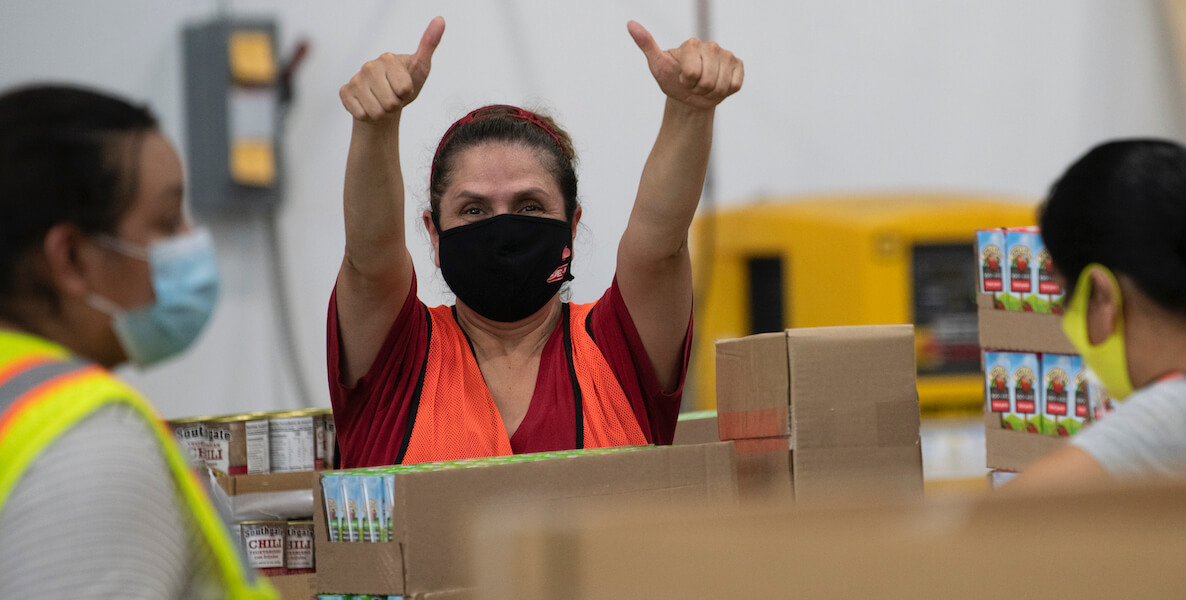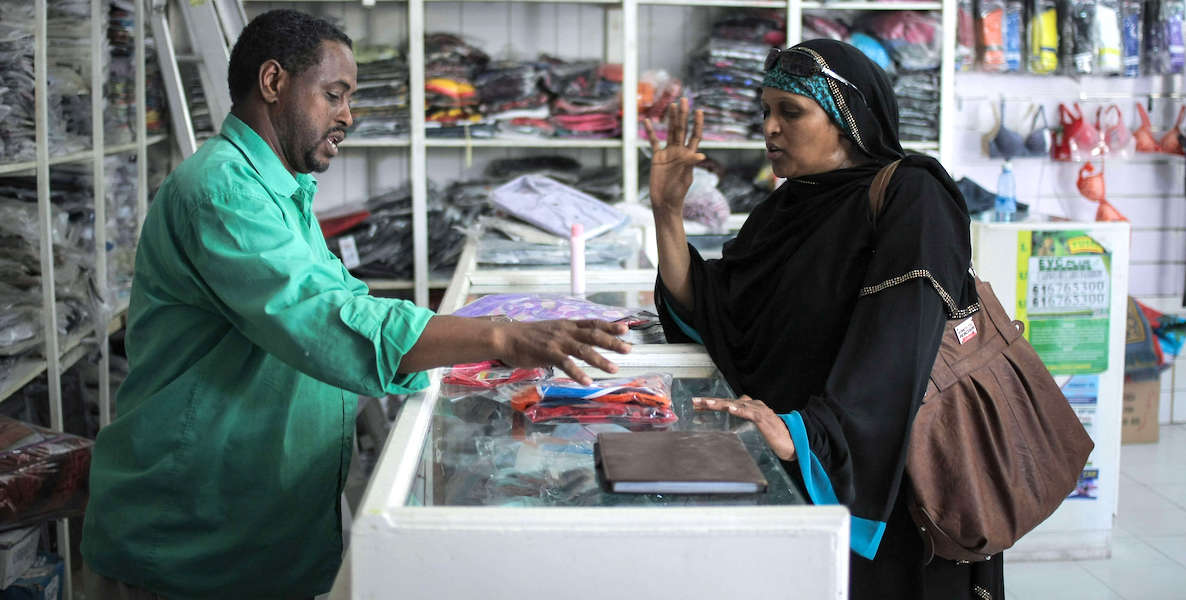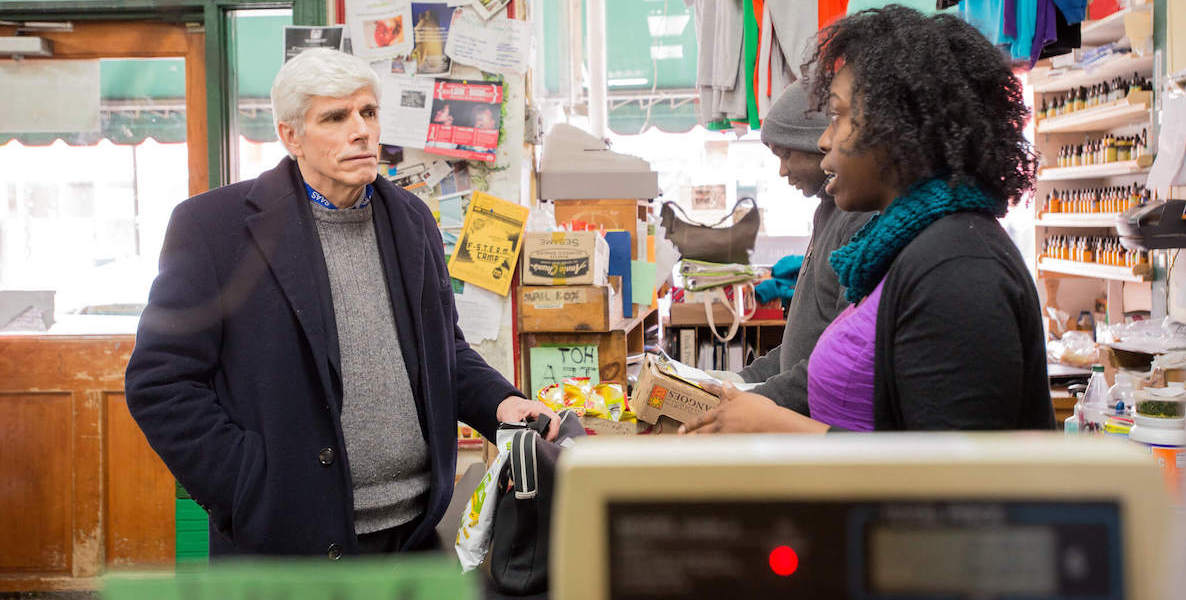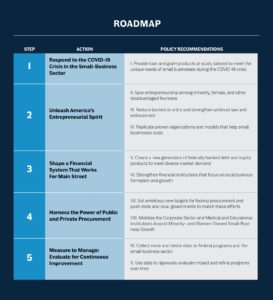The Covid-19 crisis is the greatest economic shock since the Great Depression, and it is landing hardest on our nation’s small businesses, the heart of local economies and community life.
The pandemic has reminded us of the outsized role small businesses play in our economy, employing 47 percent of the U.S. workforce, generating two-thirds of new jobs, and serving as a critical path to economic self-sufficiency.
But the pandemic has also revealed not only the fragility of many of these enterprises but profound deficiencies in how they are supported by federal policies, private practice, and local action.
The small business sector lies at the crossroads of four powerful forces: the devastation of Covid-19, a national reckoning with deep racial inequality, a long-term trend of economic consolidation and a degraded federal government.
To that end, a group of us (see full list of co-authors below) have prepared Big Ideas for Small Business. Special thanks are due to Nate Loewentheil and Jamie Rubin for conceiving of this project back in the spring.
![]() Released today by the Nowak Metro Finance Lab at Drexel University and Yale University’s Institution for Social and Policy Studies, the report calls for additional emergency measures to stabilize small businesses as well as systemic change in the way we give small businesses access to the capital, customers, and services they need to succeed.
Released today by the Nowak Metro Finance Lab at Drexel University and Yale University’s Institution for Social and Policy Studies, the report calls for additional emergency measures to stabilize small businesses as well as systemic change in the way we give small businesses access to the capital, customers, and services they need to succeed.
The numbers are stark and have four dimensions
First, Covid-19 crisis is wreaking havoc on Main Street small businesses across the United States. Since February, 2020, almost 25 percent of all U.S. small businesses have closed at least temporarily. In the hardest hit sectors, like restaurants, hotels and retail, the numbers are far higher.
In September, Yelp reported that for businesses on its platform, 60 percent of closures were permanent. Womply has estimated that 185,000 small businesses—one of every seven—had shut down permanently by the end of August. Those closures have left millions of Americans out of work and transformed lively neighborhoods around the country into retail graveyards.
(They may have also driven a sharp spike in business formation levels in the third quarter of the year, as newly unemployed individuals started new businesses, either by choice or by necessity).
Second, the impact on Black- and Latinx-owned businesses has been catastrophic. The most recent set of federal data, for example, reveals disturbing trends for Black-owned small businesses. Because these firms are smaller, operate with less capital and have less established banking relationships, they are also more likely to fold under economic pressure.
The Federal Reserve of New York reported that from February to April the number of active Black businesses declined by 41 percent. Small business must be at the center of any meaningful effort to reverse the impacts of Covid-19 in Black and Latinx communities and to help those communities build wealth.
Third, the Covid-19 crisis is accelerating the trend towards consolidation in the economy. Since the late-1990s, more than two-thirds of all U.S. industries have grown more consolidated—from dog food to airline travel.
At the same time, small business-creation has declined since the mid-2000s, whether measured by the absolute number of new businesses, per capita rates of business formation, or per capita small business job creation.
Between 2005 and 2015, for example, the number of small retailers declined by more than 20 percent. The pandemic has boosted not only the market share of e-commerce giants such as Amazon but also cemented the dominance of Dollar Stores and other publicly traded corporations in vulnerable communities.
Finally, the pandemic exposed the fault lines that run beneath the federal government’s small business programs and agencies. Prior to the onset of Covid-19, the typical annual federal budget for small business programs was under $4 billion, approximately as much as the U.S. Navy spends on a single attack submarine.
![]() Limited in its scope, authorities, reach, and human resources, the SBA could not meet the exigencies of the Covid-19 pandemic. The launch of the Paycheck Protection Program (PPP) was marred by widespread miscommunication and confusion. Roughly 4 million small businesses took out loans without any clarity on whether the loans would be forgiven or not. The failure to enact any subsequent relief products in the fall is an act of federal malpractice.
Limited in its scope, authorities, reach, and human resources, the SBA could not meet the exigencies of the Covid-19 pandemic. The launch of the Paycheck Protection Program (PPP) was marred by widespread miscommunication and confusion. Roughly 4 million small businesses took out loans without any clarity on whether the loans would be forgiven or not. The failure to enact any subsequent relief products in the fall is an act of federal malpractice.
In sum, the small business sector lies at the crossroads of four powerful forces: the devastation of Covid-19, a national reckoning with deep racial inequality, a long-term trend of economic consolidation and a degraded federal government.
The collision of these forces creates both the necessity for and the political conditions that enable a broad rethinking of how our country supports small businesses.
Five steps for building back better
In this report, we identify five steps that together form a roadmap towards a more inclusive, dynamic, and productive small-business sector:
- Come January, 2021, the federal government must forcefully respond to the Covid-19 crisis by providing debt relief and long-term loan products.
- As the economy normalizes, the federal government in partnership with states can unleash the entrepreneurial spirit of the U.S by reducing barriers to entry, leveling the playing field so small businesses can compete against incumbents, and giving entrepreneurs tools they need to succeed.
- To ensure the long-term vitality of small businesses, the federal government should shape a financial system that works for Main Street by strengthening independent banks and community financial institutions and expanding the range of federally-backed debt and equity products available to entrepreneurs of all stripes.
- But these steps will not be enough for minority small business owners, who struggle uphill against deficits of social and financial capital. To accelerate the growth of minority-owned businesses, especially Black- and Latinx-owned businesses, we call for a dramatic expansion in both public and private procurement from minority-owned small businesses. Y
- You can’t manage what you can’t measure. We must collect more and better data on the performance of the small business sector generally and specifically the impact of current and new government programs so that we can evaluate for continuous improvement.
Going even further and a call to arms
Within the five steps, we outline 10 more detailed policy recommendations. For example, our recommendations regarding the small-business financial system split out into two critical components:
First, the federal government needs to reform existing SBA programs and products to meet the unique needs of very small businesses. Lenders should be allowed to offer shorter term 7(a) loans with flexible interest rates, which will extend their credit underwriting standards.
During our discussions with market actors, we also heard that working with the SBA adds enough administrative cost that very small loans—in the range of $100,000—are inherently loss-making and therefore rare.
To remedy this, we propose that the SBA establish a new portfolio-level, first-loss guarantee program, absorbing the first 20 percent of a lender’s portfolio of small loans to disadvantaged businesses, who make up a disproportionate share of these borrowers. This program would enable technology companies to offer much smaller loans to smaller small businesses while still providing the benefit of a federal subsidy.
Second, we should strengthen financial institutions that focus on small business formation and growth. The nation’s 1100 CDFIs are often mission-driven and dedicated to working with small businesses but generally lack depository capital and are therefore chronically underfunded.
Congress has the ability to provide vital support to the CDFI sector by doubling the annual funding provided by the CDFI Fund for loans and adding a tranche of funding to enable grants, as well as by adding programmatic and technical support for cooperation and growth across the industry.
Prior to the onset of Covid-19, the typical annual federal budget for small business programs was under $4 billion, approximately as much as the U.S. Navy spends on a single attack submarine.
We recommend a similarly energetic approach to the community banking sector. Small independent banks and other local lenders like credit unions cannot hope to match the scale economics of their monolithic competitors formed by the industry’s decades of consolidation.
![]() Congress and bank regulators should recognize that not all regulation is created equal. It is possible to retain prudent oversight over big banks while minimizing the administrative burden on smaller ones, which will restore a measure of economic stability and drive affordable capital into smaller local businesses. Making interest deductible on deposits held by banks under $1 billion in assets would provide additional subsidy for small business lending.
Congress and bank regulators should recognize that not all regulation is created equal. It is possible to retain prudent oversight over big banks while minimizing the administrative burden on smaller ones, which will restore a measure of economic stability and drive affordable capital into smaller local businesses. Making interest deductible on deposits held by banks under $1 billion in assets would provide additional subsidy for small business lending.
Without major federal interventions, whole swathes of the small business sector will never return, and entrepreneurship levels could remain depressed for a generation, if not longer. The impact on individual businesses and the communities they serve will be incalculable.
But this is not just a task for the federal government. As the response to the Covid-19 crisis has revealed, the reach and impact of federal investments are maximized when they engage the full range of institutions that serve small businesses and match them to the services, customers and capital they need to succeed.
These institutions include traditional banks but also state and local governments, business chambers, incubators and accelerators, philanthropies, universities, community financial institutions, micro-lenders, and others.
The Covid-19 pandemic is precipitating a small business recession that is unprecedented in U.S. history. Our response, federal and local, public and private, must match the scale and reach of the crisis.
Co-authors: Peter Bassine, Della Clark, Gary Cunningham, Benjamin Della Rocca, Bulbul Gupta, Marie C. Johns, Bruce Katz, Nate Loewentheil, Jamie Rubin, Mary Jean Ryan, Luz Urrutia
Header photo by Lance Cheung / USDA














